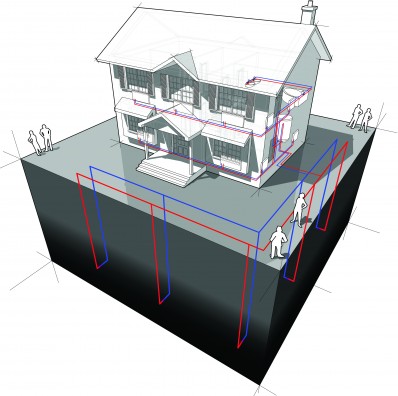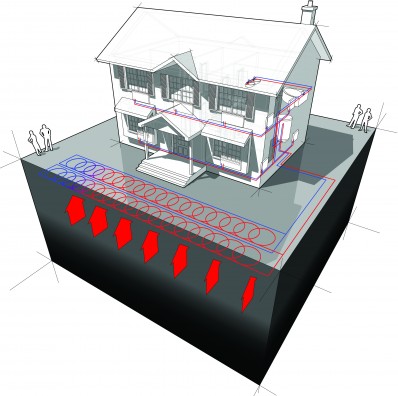Evaluation of Vertical and Horizontal Geoexchange Systems
Geoexchange systems may employ either a vertical or horizontal ground loop heat exchanger to reject or absorb heat from the ground. A vertical loop (right) is often the only option in space-constrained urban settings. It is typically more expensive to implement but can be associated with improved performance due to the more stable ground temperatures at greater depths. In contrast, a horizontal loop (left) is typically less expensive to implement but it suffers from adverse seasonal fluctuations in ground temperatures occurring near the ground surface. There is a lack of research that experimentally examines both types of ground loop for the same study site. This study attempted to fill that knowledge gap by experimentally comparing the performance of a horizontal loop with that of a vertical loop, each being attached to the same ground source heat pump and distribution system at the Living City Campus’ Archetype Sustainable House.
The vertical loop geoexchange heating and cooling coefficients of performance (COPs) during the testing period were 3.0 and 4.5, respectively. In other words, one unit of electrical energy delivered 3.0 units of heat energy during the heating season and removed 4.5 units of heat energy during the cooling season. This was comparable to, or exceeded, manufacturer performance ratings. The heating and cooling COPs associated with the horizontal loop, determined from a previous study1, were 3.0 and 3.9, respectively. This suggests that the horizontal and vertical ground loop in this particular case have comparable performance, however, it is worth noting that there were important differences in the experimental design of the two studies. It seemed that the greater volume and surface area of the horizontal loop may have been able to compensate for the poorer ground temperatures. Based on current electricity generation sources in Ontario, it is estimated that a similar sized geoexchange system would reduce annual greenhouse gas emissions by 3549 kg eCO2. These emissions reductions are on the same scale as reductions obtained by taking an average car off the road for an entire year2.
References
Alzahrani, Waleed Saeed (2014) Experimental study of the performance of a vertical and a horizontal ground loops couples to a ground source heat pump system. Master of Applied Science, Ryerson University.
1Safa, Amir Alizadeh (2012) Performance analysis of a two-stage variable capacity air source heat pump and a horizontal loop coupled ground source heat pump. Master of Applied Science Thesis, Ryerson University.
2Canadian Geoexchange Coalition Report (CGCR) (2010) Comparative Analysis of Greenhouse Gas Emissions of Various Residential Heating Systems in the Canadian Provinces, p. 28. Note: Average car emissions in Canada cited to be 3,360 eq. CO2/year within report.


